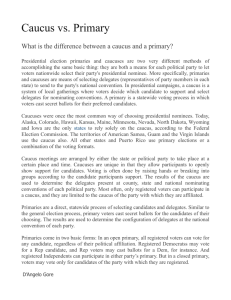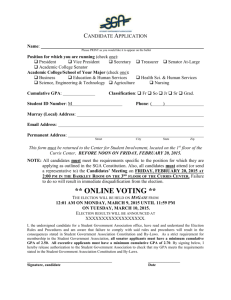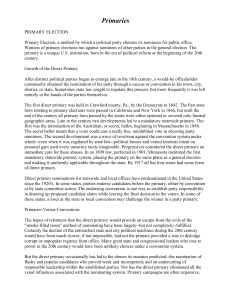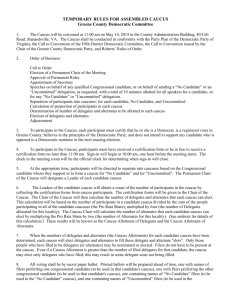Caucus / Primary Process in Colorado
advertisement
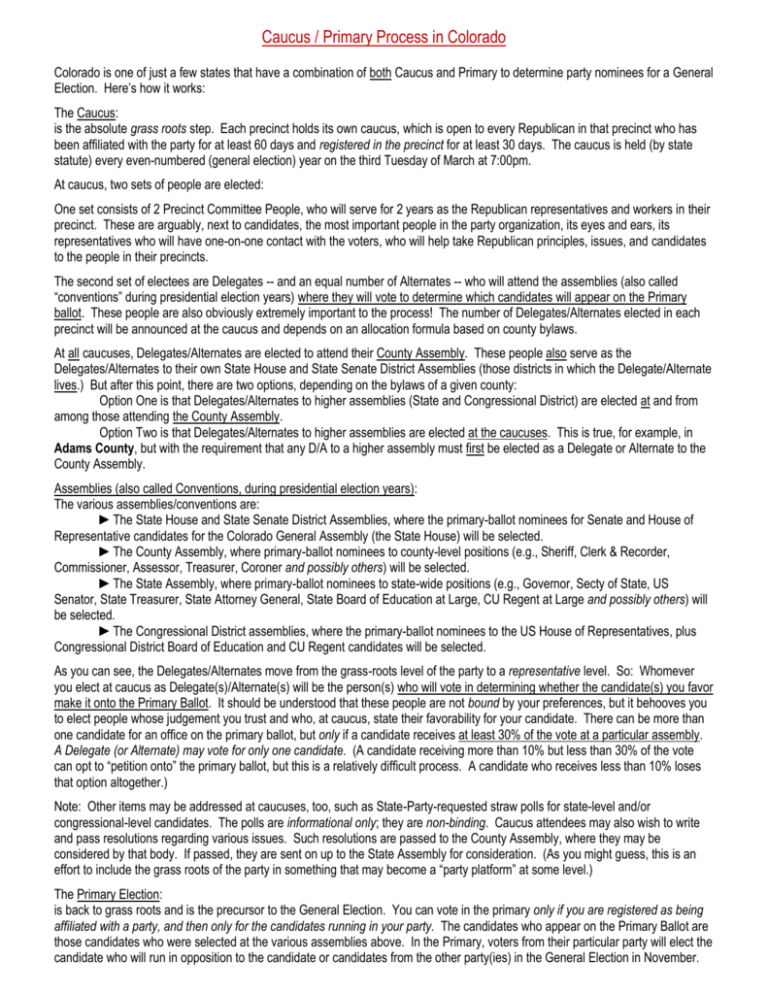
Caucus / Primary Process in Colorado Colorado is one of just a few states that have a combination of both Caucus and Primary to determine party nominees for a General Election. Here’s how it works: The Caucus: is the absolute grass roots step. Each precinct holds its own caucus, which is open to every Republican in that precinct who has been affiliated with the party for at least 60 days and registered in the precinct for at least 30 days. The caucus is held (by state statute) every even-numbered (general election) year on the third Tuesday of March at 7:00pm. At caucus, two sets of people are elected: One set consists of 2 Precinct Committee People, who will serve for 2 years as the Republican representatives and workers in their precinct. These are arguably, next to candidates, the most important people in the party organization, its eyes and ears, its representatives who will have one-on-one contact with the voters, who will help take Republican principles, issues, and candidates to the people in their precincts. The second set of electees are Delegates -- and an equal number of Alternates -- who will attend the assemblies (also called “conventions” during presidential election years) where they will vote to determine which candidates will appear on the Primary ballot. These people are also obviously extremely important to the process! The number of Delegates/Alternates elected in each precinct will be announced at the caucus and depends on an allocation formula based on county bylaws. At all caucuses, Delegates/Alternates are elected to attend their County Assembly. These people also serve as the Delegates/Alternates to their own State House and State Senate District Assemblies (those districts in which the Delegate/Alternate lives.) But after this point, there are two options, depending on the bylaws of a given county: Option One is that Delegates/Alternates to higher assemblies (State and Congressional District) are elected at and from among those attending the County Assembly. Option Two is that Delegates/Alternates to higher assemblies are elected at the caucuses. This is true, for example, in Adams County, but with the requirement that any D/A to a higher assembly must first be elected as a Delegate or Alternate to the County Assembly. Assemblies (also called Conventions, during presidential election years): The various assemblies/conventions are: ►The State House and State Senate District Assemblies, where the primary-ballot nominees for Senate and House of Representative candidates for the Colorado General Assembly (the State House) will be selected. ►The County Assembly, where primary-ballot nominees to county-level positions (e.g., Sheriff, Clerk & Recorder, Commissioner, Assessor, Treasurer, Coroner and possibly others) will be selected. ►The State Assembly, where primary-ballot nominees to state-wide positions (e.g., Governor, Secty of State, US Senator, State Treasurer, State Attorney General, State Board of Education at Large, CU Regent at Large and possibly others) will be selected. ►The Congressional District assemblies, where the primary-ballot nominees to the US House of Representatives, plus Congressional District Board of Education and CU Regent candidates will be selected. As you can see, the Delegates/Alternates move from the grass-roots level of the party to a representative level. So: Whomever you elect at caucus as Delegate(s)/Alternate(s) will be the person(s) who will vote in determining whether the candidate(s) you favor make it onto the Primary Ballot. It should be understood that these people are not bound by your preferences, but it behooves you to elect people whose judgement you trust and who, at caucus, state their favorability for your candidate. There can be more than one candidate for an office on the primary ballot, but only if a candidate receives at least 30% of the vote at a particular assembly. A Delegate (or Alternate) may vote for only one candidate. (A candidate receiving more than 10% but less than 30% of the vote can opt to “petition onto” the primary ballot, but this is a relatively difficult process. A candidate who receives less than 10% loses that option altogether.) Note: Other items may be addressed at caucuses, too, such as State-Party-requested straw polls for state-level and/or congressional-level candidates. The polls are informational only; they are non-binding. Caucus attendees may also wish to write and pass resolutions regarding various issues. Such resolutions are passed to the County Assembly, where they may be considered by that body. If passed, they are sent on up to the State Assembly for consideration. (As you might guess, this is an effort to include the grass roots of the party in something that may become a “party platform” at some level.) The Primary Election: is back to grass roots and is the precursor to the General Election. You can vote in the primary only if you are registered as being affiliated with a party, and then only for the candidates running in your party. The candidates who appear on the Primary Ballot are those candidates who were selected at the various assemblies above. In the Primary, voters from their particular party will elect the candidate who will run in opposition to the candidate or candidates from the other party(ies) in the General Election in November.


